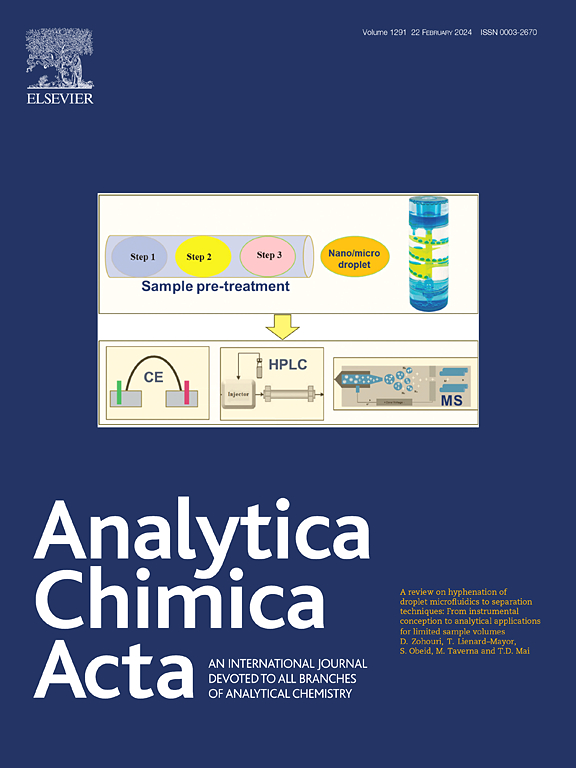具有增强漆酶样活性的介孔Ce-UiO-66用于肾上腺素快速检测和四环素类抗生素的特异性鉴定
IF 5.7
2区 化学
Q1 CHEMISTRY, ANALYTICAL
引用次数: 0
摘要
与天然漆酶的实际应用相关的挑战,如可重用性差和内在脆弱性,推动了对替代解决方案的探索。特别是,基于铈的纳米酶由于其高氧迁移率和固有的氧化还原反应性而成为有希望的候选者。但是,为了提高其催化活性,扩大其应用领域,还需要进行更深入、系统的研究。本文通过两亲分子模板和框架前体的协同组装,合成了介孔铈基MOF材料MPUiO-66(Ce)。与天然漆酶相比,MPUiO-66(Ce)的催化效率提高了约4.3倍,并且在恶劣条件下的稳定性也得到了提高。此外,MPUiO-66(Ce)的催化效率比无孔Ce- uio -66(NPUiO-66(Ce))高~ 4.0倍。这种增强可归因于其介孔结构,充当仿生口袋,为底物的有效扩散和捕获提供了有利条件。基于以上优点,MPUiO-66(Ce)分别用于比色检测肾上腺素(EP)和四环素(TC)。EP可在5 min内检测到,检测限低至400 nM,线性范围宽至10 ~ 220 μM。此外,基于MPUiO-66(Ce)的比色平台可以区分TC与其他抗生素,线性范围宽(20 ~ 250 mΜ),检出限低(810 nM)。此外,该传感平台可以准确识别血清中的EP,以及自来水、河水和土壤中的TC。该研究为设计具有更高催化活性的铈基纳米酶提供了新的途径,并突出了其在生命分析和环境监测领域的潜在应用前景。本文章由计算机程序翻译,如有差异,请以英文原文为准。

Mesoporous Ce-UiO-66 with enhanced laccase-like activity for fast detection of epinephrine and specific identification of tetracycline antibiotics
The challenges associated with the practical application of natural laccase, such as poor reusability and intrinsic fragility, have driven the exploration of alternative solutions. In particular, cerium-based nanozymes emerge as promising candidates due to their high O2 mobility and inherent redox reactivity. However, there is a need for more in-depth and systematic research to enhance their catalytic activity and expand their application areas. Herein, a mesoporous cerium-based MOF material (MPUiO-66(Ce)) was synthesized with the cooperative assembly of amphiphilic molecular template and framework precursors. Compared with natural laccase, MPUiO-66(Ce) exhibited ∼4.3-fold higher catalytic efficiency, along with enhanced stability under harsh conditions. Besides, the catalytic efficiency of MPUiO-66(Ce) was ∼4.0-fold higher than that of non-porous Ce-UiO-66 (NPUiO-66(Ce)). This enhancement can be attributed to its mesoporous structure, which acted as bionic pockets and provided favorable conditions for the effective diffusion and capture of substrates. Based on the above advantages, MPUiO-66(Ce) was employed for colorimetric sensing epinephrine (EP) and tetracycline (TC), respectively. EP can be detected within 5 min, resulting in a low detection limit of 400 nM and a broad linear range of 10–220 μM. Besides, the MPUiO-66(Ce)-based colourimetric platform could discriminate TC from other antibiotics, showing a wide linear range (20–250 mΜ) and a low detection limit of 810 nM. Furthermore, this sensing platform can accurately identify EP in serum, as well as TC in tap water, river water and soil. This work provided a new approach for designing cerium-based nanoenzymes with improved catalytic activity and highlighted their potential applications in the fields of life analysis and environmental monitoring.
求助全文
通过发布文献求助,成功后即可免费获取论文全文。
去求助
来源期刊

Analytica Chimica Acta
化学-分析化学
CiteScore
10.40
自引率
6.50%
发文量
1081
审稿时长
38 days
期刊介绍:
Analytica Chimica Acta has an open access mirror journal Analytica Chimica Acta: X, sharing the same aims and scope, editorial team, submission system and rigorous peer review.
Analytica Chimica Acta provides a forum for the rapid publication of original research, and critical, comprehensive reviews dealing with all aspects of fundamental and applied modern analytical chemistry. The journal welcomes the submission of research papers which report studies concerning the development of new and significant analytical methodologies. In determining the suitability of submitted articles for publication, particular scrutiny will be placed on the degree of novelty and impact of the research and the extent to which it adds to the existing body of knowledge in analytical chemistry.
 求助内容:
求助内容: 应助结果提醒方式:
应助结果提醒方式:


